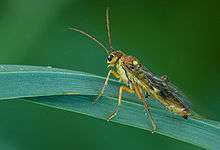Tenthredinidae
| Tenthredinidae | |
|---|---|
 | |
| Female Tenthredopsis sordida | |
| Scientific classification | |
| Kingdom: | Animalia |
| Phylum: | Arthropoda |
| Class: | Insecta |
| Order: | Hymenoptera |
| Suborder: | Symphyta |
| Superfamily: | Tenthredinoidea |
| Family: | Tenthredinidae Latreille, 1802[1] |
| Type genus | |
| Tenthredo | |
| Subfamilies | |
|
Allantinae | |
Tenthredinidae is the largest family of sawflies, with well over 7,500 species worldwide,[2] divided into 430 genera. Larvae are typically herbivores and feed on the foliage of trees and shrubs, with occasional exceptions that are leaf miners, stem borers, or gall makers. The larvae of externally feeding species resemble small caterpillars. As with all hymenopterans, common sawflies undergo complete metamorphosis.
The family has no easily seen diagnostic features, though the combination of five to nine antennal flagellomeres plus a clear separation of the first abdominal tergum from the metapleuron can reliably separate them. These sawflies are often black or brown, and from 3–20 mm long. Like other sawflies, they lack the slender "wasp-waist", or petiole, between the thorax and abdomen, characteristic of many hymenopterans . The mesosoma (or thorax) and the metasoma (abdomen) are instead broadly joined. The Tenthredinidae are also often somewhat dorsoventrally flattened, which will distinguish them at least from the slender cephids (which, together with the common sawflies, comprise many of the Nearctic species of Symphyta).
Females use their saw-like ovipositors to cut slits through barks of twigs, into which translucent eggs are wedged, which damages the trees. They are common in meadows, and in forest glades near rapid streams. Adults eat little, while larvae feed on foliage of streamside trees and shrubs, especially willow.
A number of species and genera have been described from the fossil record such as Eriocampa tulameenensis and Pseudosiobla campbelli of British Columbia.[3]
Taxonomy
The Tenthredinidae are divided into seven subfamilies. Of the 430 genera, nine contain greater than 50 species.
Subdivision
Subfamilies;
- Allantinae (110)
- Blennocampinae (105)
- Heterarthrinae (40)
- Nematinae (55)
- Selandriinae including Dolerinae (75)
- Susaninae (1)
- Tenthredininae (50)
Phylogeny
Of these subfamilies, Tenthredininae and Allantinae are sister groups, and in turn form a sister group to the Nematinae. [4]
References
- ↑ Liston et al 2014.
- ↑ Davis, Robert B; Baldauf, Sandra L; Mayhew, Peter J (2010). "The origins of species richness in the Hymenoptera: insights from a family-level supertree". BMC Evolutionary Biology. 10 (1): 109. doi:10.1186/1471-2148-10-109. ISSN 1471-2148.
- ↑ Rice, H.M.A. (1968). "Two Tertiary sawflies, (Hymenoptera – Tenthredinidae), from British Columbia". Geological Survey of Canada. 67 (59): 1–21.
- ↑ Song et al 2016.
Bibliography
- Asaro, Christopher. Sawflies (Hymenoptera: Symphyta). pp. 3250–3252., in Capinera (2008)
- Boevé, Jean-Luc. Sawflies (Hymenoptera: Tenthredinidae). pp. 3252–3257., in Capinera (2008)
- Capinera, John L., ed. (2008). Encyclopedia of Entomology (2nd ed.). Dordrecht: Springer. ISBN 978-1-4020-6242-1.
- Blank, S.M.; Groll, E.K.; Liston, A.D.; Prous, M.; Taeger, A. (2012). "ECatSym - Electronic World Catalog of Symphyta (Insecta, Hymenoptera). Program version 4.0 beta, data version 39". Müncheberg: Digital Entomological Information.
- Blank, S.M.; Taeger, A. (1998). Comments on the taxonomy of Symphyta (Hymenoptera) (PDF). pp. 141–174., in Taeger, A. & Blank, S. M. (eds.), Pflanzenwespen Deutschlands (Hymenoptera, Symphyta) Kommentierte Bestandsaufname. Deutsches Entomologisches Institut, Goecke& Evers, Keltern.
- Goulet, Henri; Huber, John T., eds. (1993). Hymenoptera of the world: An identification guide to familes (PDF). Ottawa: Agriculture Canada. ISBN 0-660-14933-8.
- Liston, Andrew; Knight, Guy; Sheppard, David; Broad, Gavin; Livermore, Laurence (29 August 2014). "Checklist of British and Irish Hymenoptera - Sawflies, 'Symphyta'". Biodiversity Data Journal. 2: e1168. doi:10.3897/BDJ.2.e1168.
- Smith, David R (September 1969). Nearctic sawflies I. Blennocampinae: Adults and larvae (Hymenoptera: Tenthredinidae) (Technical Bulletin 1397). Washington: US Department of Agriculture. Retrieved 7 September 2016.
- Smith, David R (September 1969). Nearctic sawflies II.Selandriinae: Adults and larvae (Hymenoptera: Tenthredinidae) (Technical Bulletin 1398). Washington: US Department of Agriculture. Retrieved 8 September 2016.
- Smith, David R (January 1971). Nearctic sawflies III. Heterarthrinae: Adults and larvae (Hymenoptera: Tenthredinidae) (Technical Bulletin 1420). Washington: US Department of Agriculture. Retrieved 7 September 2016.
- Smith, David R (June 1979). Nearctic sawflies IV. Allantinae: Adults and larvae (Hymenoptera: Tenthredinidae) (Technical Bulletin 1595). Washington: US Department of Agriculture. Retrieved 30 August 2016.
- Smith, David R (March 2003). "A Synopsis of the Sawflies (Hymenoptera: Symphyta) of America South of the United States: Tenthredinidae (Nematinae, Heterarthrinae, Tenthredininae)". Transactions of the American Entomological Society. 129 (1): 1–45. JSTOR 25078795.
- Song, Sheng-Nan; Tang, Pu; Wei, Shu-Jun; Chen, Xue-Xin (16 February 2016). "Comparative and phylogenetic analysis of the mitochondrial genomes in basal hymenopterans". Scientific Reports. 6: 20972. doi:10.1038/srep20972.
- Skvarla, Michael; Smith, David; Fisher, Danielle; Dowling, Ashley (9 May 2016). "Terrestrial arthropods of Steel Creek, Buffalo National River, Arkansas. II. Sawflies (Insecta: Hymenoptera: " Symphyta ")". Biodiversity Data Journal. 4: e8830. doi:10.3897/BDJ.4.e8830.
External links
- Hymis de Image gallery
| Wikispecies has information related to: Tenthredinidae |
| Wikimedia Commons has media related to Tenthredinidae. |